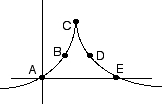- \( \displaystyle \int_{-a}^{a} \cos{x} \, dx = 2\int_0^a \cos{x} \, dx \)
- \( \displaystyle \int_a^c \cos{x} \, dx + \int_c^b \cos{x} \, dx = \int_a^b \cos{x} \, dx \)
- \( \displaystyle \int_{-a}^{a} \cos{x} \, dx = 0\)
- I only
- II only
- I and II
- II and III
- I, II, and III
Solution
C- \( \displaystyle \frac{1 - cos 2t}{ t}\)
- \( \displaystyle \frac{1 - cos 2t}{2t}\)
- \(\sin {(2t)}\)
- \(2 \sin {(2t)}\)
- \( \displaystyle \frac{2t \sin {(2t)} + \cos {(2t)}}{2t^2}\)
Solution
A- -1
- 0
- 1
- 2
- undefined
Solution
C
Solution
D- \( \displaystyle -\frac{1}{2}\)
- 0
- \( \displaystyle \frac{1}{2}\)
- 1
- does not exist
Solution
E
- \(f(2) = 2\)
- \( \displaystyle \lim_{x \to 2^-} f(x) = 1\)
- \( \displaystyle \lim_{x \to 2} f(x) = 1 \)
- \( \displaystyle f'(0) = \frac{1}{2}\)
- \(f'(x)\) does not exist at \(x = 2 \)
Solution
C
Solution
D- no critical points
- one relative minimum and one relative maximum
- two relative minima and one relative maximum
- two relative minima and two relative maxima
- three relative minima and one relative maximum
Solution
B- \(- \sqrt{3}\)
- -1
- 0
- 1
- \(\sqrt{3}\)
Solution
C- \(Ce^{-t} \)
- \(Ce^t \)
- \(e^t + C\)
- \(e^{-t} + C\)
- \(-e^{-t} + C \)
Solution
E- -9
- -6.348
- 0
- 1
- 14.697
Solution
E- 10.0 mph
- 25.823 mph
- 54.46 mph
- 40.00 mph
- 34.641 mph